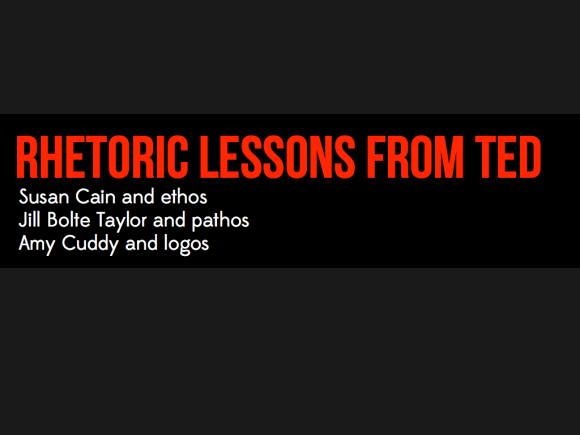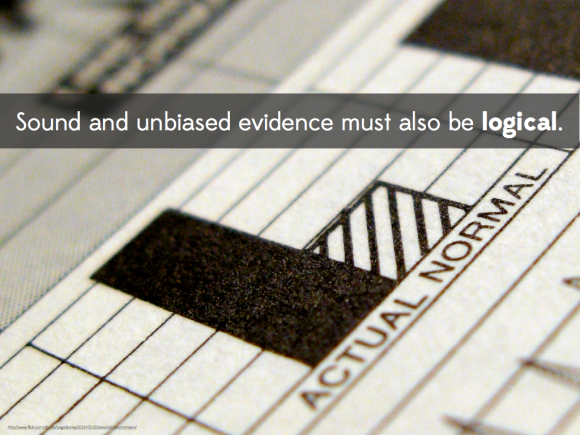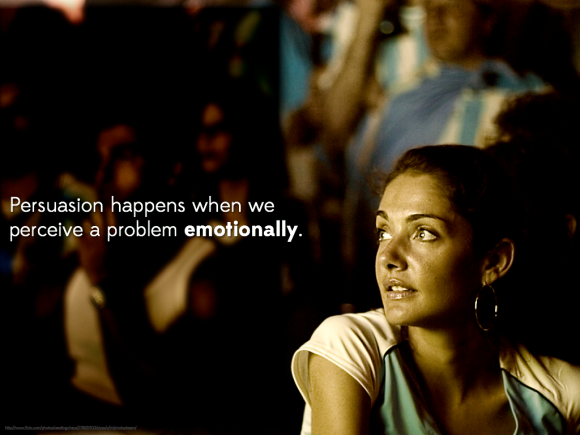The three cornerstones of public speaking, credibility, emotion, and logic, have been drilled into countless students of both written and oratory rhetoric. This is done with good reason. Aristotle, a man whose insights permeate philosophy, literature, and the arts, knew his stuff. He codified the very science and art of persuasion, while also engaging in one of the first forms of psychological analysis of the human mind’s response to the rhetorical appeals. Aristotle brings light to three important aspects of the human psyche; these directly relate to a speaker’s ability to most effectively persuade a given audience in a specific situation:
We trust speakers who we judge as credible, and trust is a relative term based on a series of variables. This is ethos.
We demand sound, unbiased, and clear evidence placed into a logical organization and pattern. This is logos.
We are only persuaded when we are led to feel something, to perceive the problem emotionally. This is pathos.
Earlier this week, Alex Rister of Creating Communication shared this excellent video with her readers that helps further explain just how important each of these are in our age of information overload. Conor Neill, the creator of this excellent new TED-ED resource, asserts that it’s the balance and interplay between all three of these areas that leads to true persuasion.
Rhetoric in Action
Susan Cain Photo Credit: jurvetson via Compfight cc; Jill Bolte Taylor Photo Credit: cr8it via Compfight cc; Amy Cuddy Photo Credit: poptech via Compfight cc
One way to tap into the power of rhetoric is to study how great speakers apply the three appeals, ethos, pathos, and logos. Let’s take a look at how three TED presenters put rhetorical theory into practice in their presentations.
Susan Cain’s “The Power of Introverts”: Improve ethos through shared experience
Cain does a masterful job of developing her ethos, which is a blend of trustworthiness, similarity, reputation, and authority (Dlugan 2010), by drawing on personal stories–her experience being an introvert at “ROWDIE” camp, her choice to write a book and her determination to share her suitcase of ideas with the world. These personal stories build her reputation and authority. But, what really lends her complete credibility is her use of similarity. Cain connects her stories to our shared experiences, our culture of character, our culture of personality, our workplaces, our schools. She draws from the world’s most respected introverts, Abraham Lincoln, Ghandi, in describing the power of introverts. Cain places all of her audience in the problem her big idea helps to solve–we have big problems in the world; we need to value the power of introspection, solitude, and self-reflection on the human experience.
Jill Bolte Taylor’s “A Stroke of Insight”: Improve pathos by showing you care
Bolte Taylor’s talk was one of the first I watched and one of the first I shared with my students. Reception to this talk is always mixed–some students completely dig Taylor’s big idea–that we can choose to step into a right-hemisphere state of mind where we view ourselves as part of a collective universal being. Other students find Taylor’s message to be too “touchy-feely.” Regardless of reception, one cannot help but be impacted by Taylor’s delivery. As a neuroanatomist, we expect Taylor to be cold, detached, scientific. This perception is reinforced by her matter of fact explanation of the human brain while holding an actual human brain. But, Bolte Taylor jarrs the audience’s perceptions by channeling the power of pathos. The experience of having a stroke is conveyed through emotive and physical storytelling. Taylor weaves in beautiful metaphors and invites her audience to experience the stroke that led her to her shareable idea. It’s her willingness to let the audience see her vulnerability, her acceptance of death, her realization that life is not really about me but about we that leads to true persuasion.
Amy Cuddy, “Body language”: Improve logos by visualizing evidence
The content of Cuddy’s TED talk on body language is useful in considering the impact what we do not say when we present can have on an audience’s perceptions and their willingness to accept a message. But, when we move beyond content to analyze the structure and delivery of this message, an important lesson about how to integrate examples and evidence emerges. Cuddy sets the tone for the presentation by calling attention to the body, by asking her audience to become aware of their bodies. Immediately, the audience is put into the mindframe of the presentation’s big idea–that body language does more than just reflect mood; body language can change and shape our minds and in turn our behavior. She then tells the story that led to this big idea, interweaving testimony, examples, and case studies paired with video, images, and simple data display. As a viewer, I found myself hypersensitive to my posture and body language for the duration of the speech: I mimicked the power poses; I recalled the many times I’d noticed myself and others displaying the non-verbal behavior Cuddy describes and displays. Cuddy’s rich examples bring her logic to life and help her achieve her goal–to persuade her audience to “fake it til you become it”, to use body language as a means for personal growth and change.
Note that these speakers all used the three appeals together. Rhetorical appeals do not exist in a vacuum; they work with each other. I like to think of a strong argument as the Starship Enterprise–Star Trek the series and the Enterprise as a ship work because of the interplay between Spock (logos), McCoy (ethos), and Kirk (pathos). Without these three, the Enterprise crew cannot function; without these three, there would be no Trek. Tap into the three rhetorical appeals and bring your big idea to life in a way that will truly move your audience to action.






Three great speeches that do a great job of showing how someone can play strong on Logos, on Ethos or on Pathos. Later on in his life, Aristotle felt that Ethos was the most important… but he didn’t like the idea that we humans are so easily swayed by a credible speaker – so he focussed most of his work on developing a rhetoric based strongly on Logos. I think it is important that speakers start with Logos, but know that even if they develop the logic of the idea, they will not be heard without developing their credibility, and their ability to rouse emotion in the heart of the listener. Keep up the fantastic blog.
Hi Conor! Thank you for your input and encouragement. Alex and I discuss this with students each month–which of the three appeals is the most important? I agree with Aristotle–in a rational world, logos is all we actually need (probably explains my love of Spock), but in actuality, people don’t respond to cold logic–they respond to authority as well and to the basic human experience (if it connects with their own). As speakers, our ideas are powerless without that person being impacted by them (as your anecdote illustrated). Logos has to be the beginning as you say, and it’s the perfect interweaving of the other two appeals within this rational construct that leads to true persuasion. Man, Aristotle rules…